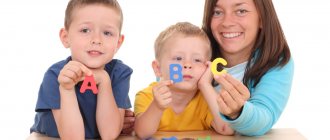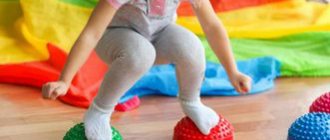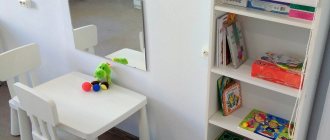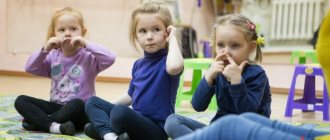Speech hearing and phonemic hearing
Hearing is a person’s ability to perceive sounds and navigate the environment.
It is customary to distinguish:
- Non-speech (physical) hearing. Allows you to perceive natural and everyday noises: steps, driving a car, rustling leaves, murmur of water, etc. It also includes hearing for music.
- Speech (phonemic) hearing. Responsible for understanding and reproducing human speech. With its help, the child masters the “code” of the language.
Speech hearing is a complex ability that is formed during life. Sound speech consists of phonemes (sounds), intonations, pauses, and stress. It allows you to catch them and distinguish them. For example, with its help a person distinguishes a castle from a castle, a bear from a bowl, a goat from a braid, etc.
Take a hearing test online
What does a hearing test tell you?
An online hearing test allows you to quickly and easily determine your hearing status. In just 3 minutes you can determine its spiciness. The result of the hearing test is called an “audiogram” and is an indication for doctor’s prescriptions.
We suggest the following hearing tests: signs of hearing loss; online frequency hearing test; hearing test in noise; speech recognition; modeling signs of hearing loss.
Take a hearing test
Which hemisphere is responsible for speech hearing?
A person perceives sounds with the help of the organ of Corti - a labyrinth in which sound cells float in the lymph. From here begins the complex path of sounds from the ear to the temporal part of the cerebral cortex - 41 fields. This zone is also called the auditory zone.
Depending on the frequency of sound vibrations, different cells are excited in individual parts of the organ of Corti. They act on nerve endings, and the vibrations are converted into nerve impulses that enter the cerebral cortex. Sounds of different pitches are directed to different areas of the cortex.
All information from the left and right ears first reaches both hemispheres of the brain. However, sounds are processed separately in special areas of the cortex. The left hemisphere of the brain is responsible for recognizing phonemes. But the right hemisphere also participates in speech hearing - it analyzes different voices and intonations.
What is phonemic awareness?
As mentioned earlier, phonemic awareness is the ability of a person to analyze and synthesize speech sounds that provide the perception of phonemes of a foreign or native language. Phonemes are the minimal units of the sound structure of a language, through which the construction and distinction of morphemes, words and entire sentences is carried out.
Phonemic hearing includes 3 speech operations:
- The ability to recognize the presence of a specific sound in a word.
- The ability to distinguish words that contain identical phonemes that are located in different orders.
- The ability to distinguish words that have different meanings, but have the same or similar sound.
Every language we know has its own set of phonemic features, which creates their sound structure.
Features of development
Speech perception begins to form from the first months of a child’s life. At 1 month, the baby can already pick up speech. At 3-4 months he tries to repeat it, which is manifested by humming. Every month he gets better at it.
The development of the ability to understand speech is greatly influenced by auditory attention and auditory memory. Long-term memory contains a storage device called the “phoneme lattice.” In it, for each phoneme a certain standard is assigned (allowing deviations within certain limits). In other words, during the formation of speech hearing, significant signs of sounds are stored in memory. The child accumulates a certain “baggage” of phonemes.
As concentration increases and other mental functions develop, speech perception also improves. The main development of speech hearing occurs in the first 2–3 years of a person’s life. And although the child is not yet able to reproduce everything correctly, in the absence of violations he fully understands his native language.
Formation of speech hearing and pronunciation aspects of speech
The development of speech perception is closely related to the formation of speech. Sensations associated with the work of the organs of articulation improve the understanding of phonemes. As perception develops, the child begins to analyze the correctness of pronunciation, identify and correct errors.
Games have a positive effect on the development of hearing and speech. For example:
- "Broken phone". Children sit in a row. The first player comes up with a word and whispers it in his neighbor's ear. He passes on what he heard further. The last one in the chain says the word out loud. The goal of the game is to correctly hear and convey what is said.
- "Magic Mirror". The guys choose a leader. He approaches one of the players to choose from and says: “Come on, mirror, look, repeat everything to us correctly!” I will stand in front of you, and you repeat after me.” Then he makes a movement and says a short phrase. The player must repeat everything exactly. If he makes a mistake, he drops out of the game, if not, he becomes the leader.
The development of the pronunciation side of speech ends by 4–5 years. At 5 years old, the organs of articulation are sufficiently formed to clearly reproduce all sounds, with the exception of [р], [р']. Normally, a five-year-old child is also able to regulate the volume of speech, pronounce words correctly, construct sentences, and use different intonations.
Speech hearing and speech culture
Speech culture is the ability to correctly use all language means: sounds, intonation, vocabulary, grammatical forms. A high culture of speech is characteristic of speakers, actors, poets, and journalists. Children master it in the process of communication, listening to fairy tales and poems. Speech hearing ensures correct pronunciation, capturing intonations, pauses, etc.
To improve speech culture, it is necessary to develop:
- correct speech breathing,
- control over voice strength, speech speed, intonation.
Speech hearing
Try to tell a person who dreams of learning to play the violin or piano that he has no ear for music, and he will be very upset.
But if you say to a person studying the Russian language: “You have no hearing for speech,” then you risk hearing in response: “Just think, how important is it, I can live without hearing for speech.” However, “living,” that is, learning the Russian language (like any other language in general) without an ear for speech, is just as difficult as learning to play an instrument without an ear for music.
One may ask, what is speech hearing and what are its distinctive properties?
Speech hearing is the ability to distinguish a wide variety of shades in the sound of certain words, combinations, sentences and phrases. With the help of speech hearing, a person masters the ability to read and speak correctly. Speech hearing helps him easily master such a complex and difficult section of spelling as punctuation.
We started talking about speech hearing in order to talk about one student who could not master the art of expressive reading, although he had dramatic abilities.
Imitating his favorite artists, he successfully acted out the roles of famous stage characters on the school stage. But when it came to expressive reading, where independent thought and the ability to express deep feelings were required, he was shamelessly false, distorting the author’s artistic intention.
Teachers told him more than once: “Petrov, you are a capable person, but you have no ear for speech, you confuse types of intonation: enumerative with narrative, intonation of opposition with intonation of comparison. The intonation of warning, the outcome does not exist for you at all. But most importantly, the lack of hearing for speech prevents you from correctly placing logical stresses and pauses in those places where they should be placed according to the thoughts of the author and the reader himself.”
We recommend reading: How to say correctly: extreme or last?
And indeed, the most unexpected incidents happened to Petrov during Russian language and literature lessons. So, for example, the sentence:
Your living silence, your dashing bad weather, your forests, your meadows and the joyful waters of the Volga - everything is dear to me,
- in which the poet Yazykov, with the help of a clear enumerative intonation, a pause and a pronounced logical emphasis on a generalizing word, conveys his enthusiastic attitude towards his homeland, Petrov managed to convey in such a mutilated form:
“Your living silence, your dashing bad weather, your forests, your meadows and the joyful waters of the Volga - everything is dear to me.”
Another time, he caused disapproving remarks from the teacher and loud laughter from the entire class by confusing an exclamatory sentence with an interrogative one and, instead of reading from Pushkin:
Hooray! we break; The Swedes are bending. O glorious hour! O glorious view! Another push and the enemy flees...
read:
Hurray are we breaking? The Swedes are bending. Oh glorious hour, oh glorious view, Another pressure and the enemy flees?
His oral speech was replete with many phonetic errors associated with the inability to distinguish individual sounds, in particular, with the inability to distinguish between the pronunciation of consonant sounds before the separating soft sign (ь) and the dividing hard sign (ъ).
All this continued until he finally heeded the advice of his teachers and began to work seriously and persistently on developing his speech hearing.
He began to spend a lot of time working on the intonation of simple and complex sentences. Practically (using his ear) he mastered the rules of punctuation and spelling, and a year later he pleased his comrades and teachers with the logically correct, figurative and emotional performance of literary works. And when his comrades, in his presence, sometimes remembered the student whose “bear stepped on his ear,” Petrov laughed it off: “It came, but I outwitted him.”
We recommend reading Correct use of personal pronouns
- How could you?
- It’s very simple.
And Petrov listed the most important and useful exercises for the development of speech hearing:
1. When you listen to another person’s speech, try to establish logical-syntactic relationships in it and thus better understand his thoughts.
2. Learn to determine by ear what type of sentences are dictated by the teacher, and in this regard, place punctuation marks in them.
3. Practice pronouncing sentences with clearly defined narrative and enumerative intonation, comparison and contrast intonation, question intonation in exclamations, etc.
4. Learn to read punctuation marks expressively.
5. Practice raising and lowering your voice; in speeding up and slowing down the rate of speech.
6. Learn to correctly determine the main idea of a statement, find words that have logical emphasis. Practice placing logical stress on any word in a sentence and carefully watch for changes in semantic shades, for example:
There are many beautiful buildings in our city (specifically in ours, not in others)…
There are many beautiful buildings in our city (in the city, not in the village)…
There are many beautiful buildings in our city (many, not few)…
There are many beautiful buildings in our city (some beautiful, some ugly)…
Our city has many beautiful buildings (buildings, not shacks).
7. Learn to read expressively.
8. Listen carefully to the speech of teachers, announcers, theater and film artists.
9. Listen to good music and opera excerpts.
10. Attend concerts by masters of artistic expression.
Natalya Vasilievna
Teacher of Russian language
Ask a Question
Development of speech hearing and breathing
Correct speech breathing is an integral component of expressive speech. To speak fluently in phrases, you need to be able to take a short breath and exhale smoothly and long. Children who cannot control their breathing “choke” mid-sentence, lose the sonority of their voice, and mumble their words. Pronunciation suffers, and along with it, speech hearing does not develop.
To develop phonemic hearing, classes are held, including on the development of speech breathing. Example exercise:
"Bubbles." Children repeat a poem after an adult and at the same time wave their brushes towards themselves: “Hey, little mouse, look, we’re blowing bubbles.” In the next part of the poem, before naming the color, you need to puff out your cheeks and quickly exhale: “Blue, red, light blue - choose any one!”
Normally, a child 2–3 years old can utter 2–3 words while exhaling, 3–4 years old – 3–5 words, 4–6 years old – 5–6 words.
Speech hearing impairment
In early childhood, a child hears words unclearly and with distortion. Until the age of 2–3 years, he still does not fully understand spoken speech. Therefore, we can talk about speech hearing impairment only after reaching 3 years of age. It is installed by a specialist – a speech therapist. At such an early age, deviation is mainly indicated by the incorrect interpretation of individual words. For example, an adult asks to show a midge in the picture, and a child shows a cat.
Obvious signs of speech hearing impairment are detected after the final formation of the articulatory apparatus. At 5 years old, a child is already physiologically capable of reproducing phonemes. If he makes gross mistakes, this may be a sign of impaired phonemic hearing. Examples of such errors:
- replacing and mixing sounds;
- rearrangement of letters, syllables;
- omission or insertion of extra letters;
- incorrect stress in words.
The cause of impaired speech perception can be both pedagogical neglect and various pathologies: hearing loss, ADHD (attention deficit hyperactivity disorder), head injuries and diseases associated with inflammation of the brain.
Features of speech development of children with hearing impairment
Overcoming phonemic perception disorders is one of the main areas of speech therapy work. A properly designed set of classes helps to completely solve the problem in 3–12 months. If indicated, correction is carried out against the background of drug treatment or after it.
Speech therapy work includes 3 stages:
- Development of the ability to distinguish sound from the background of a word.
- Developing the skill of isolating sounds at the beginning, end and middle of a word.
- Formation of complex phonemic analysis: number, sequence of sounds, location, etc.
All exercises are veiled - they are carried out in the form of interesting games. The complex is developed for each child individually, depending on the severity and nature of the disorders. The main work is carried out by a specialist. At home, it is also useful to play games with your child that develop physiological breathing, phonemic hearing, analysis, auditory attention and memory.
If you don't intervene in time, the problem will get worse. The developmental features of children with speech hearing impairment are clearly evident at school. Already from the first year of study, they find themselves in the category of lagging students . Impaired speech perception entails gross errors in writing: “breathing” instead of “sentence”, “leste” instead of “leaves”.
Speech hearing is an ability that develops independently in the absence of diseases and in a favorable social environment. Receiving speech sounds, the brain remembers them and creates certain “standards”. Later he focuses on them, correcting the correct pronunciation. That is why it is so important in the first years of life to talk with the child often, without resorting to baby talk, to read a lot, to learn poetry and tongue twisters. But even if time is lost or perception is impaired as a result of illness, one should not despair. Speech hearing, like musical hearing, can be developed throughout life. The main thing is not to let the problem take its course!
Formation and development of speech hearing in preschool children
Formation and development of speech hearing.
- Formation and development of speech hearing
Speech hearing is a broad concept. It includes the ability for auditory attention and understanding of words, the ability to perceive and distinguish different qualities of speech: timbre (Find out by voice who called you?), expressiveness (Listen and guess, was the bear scared or happy?).
Developed speech hearing also includes good phonemic hearing, i.e. the ability to differentiate all the sounds (phonemes) of the native language - to distinguish the meaning of words that sound similar (duck - fishing rod, house - smoke).
Speech hearing begins to develop early. A child aged two to three weeks has a selective reaction to speech and voice; at 5-6 months he reacts to intonation, and somewhat later - to the rhythm of speech; By about two years, the baby can already hear and distinguish all the sounds of his native language. We can assume that by the age of two, a child has developed phonemic hearing, although at this time there is still a gap between the assimilation of sounds by ear and their pronunciation.
Having phonemic awareness is sufficient for practical speech communication, but this is not enough for mastering reading and writing. When mastering literacy, a child must develop a new, higher level of phonemic awareness - sound analysis or phonemic perception: the ability to determine which sounds are heard in a word, determine their order and quantity. This is a very complex skill, it involves the ability to listen attentively to speech, to keep in memory the word heard, the sound named.
Work on the formation of speech hearing is carried out in all age groups. A large place is occupied by didactic games for the development of auditory attention, i.e. the ability to hear a sound and relate it to the source and place of presentation. In younger groups, games conducted during speech classes use musical instruments and voiced toys so that children learn to distinguish the strength and nature of sound. For example, in the game “Sun or Rain?” children walk calmly when the teacher rings the tambourine, and run into the house when he knocks on the tambourine, imitating thunder; in the game "Guess what to do?" When the sounds of a tambourine or rattle are loud, children wave flags; when sounds are weak, they lower the flags to their knees. Widespread games are “Where did they call?”, “Guess what they are playing on?”, “What is Parsley doing behind the screen?
In older groups, children’s auditory perceptions are developed not only through games similar to those described above, but also by listening to radio broadcasts, tape recordings, etc. Short-term “minutes of silence” should be practiced more often, turning them into “Who can hear more?” exercises. , “What is the room talking about?” As these exercises progress, you can ask individual children to use onomatopoeia to reproduce what they heard (water dripping from a tap, a squirrel wheel whirring, etc.).
Another category consists of games for the development of speech hearing itself (for the perception and awareness of speech sounds and words). Currently, a collection of games dedicated to working with children on the sound side of words and the development of speech hearing has been released for educators. The collection offers games for each age group (lasting 3-7 minutes), which it is advisable to play with children 1-2 times a week in and outside of class. A methodologist, when recommending this manual to educators, must emphasize the novelty of the concept of these games, because this is an introduction to children not with the semantic, but with the sound (pronunciation) side of words.
Already in the younger group, children are asked to listen attentively to the sound of speech, distinguish its various qualities by ear, and “guess” them (the word is spoken in a whisper or loudly, slowly or quickly). So, for example, the game “Guess what I said?” encourages the child to listen attentively to the speech of the teacher and peers. This is facilitated by the game rule, which the teacher says: “I will speak quietly, you listen carefully and guess what I said. Whoever I call will say loudly and clearly that he heard.” The content of the game can be made more rich if you include in it for guessing material that is difficult for children, for example, in the middle group - words with hissing and sonorant sounds, in the older group - polysyllabic words or words that are difficult in orthoepic terms, close to each other in sound (juice -suk), as well as sounds.
Middle age is the time to improve auditory perception and phonemic hearing. This is a kind of preparation of the child for the subsequent mastery of sound analysis of words. In a number of games that are played in this age group, the task is of increased complexity - from the words called by the teacher, by ear, select those that have a given sound (for example, z - the song of a mosquito), marking them with a clap of your hands, a chip. Auditory perception facilitates the slow pronunciation of a word or the prolonged pronunciation of a sound in a word.
In older groups, naturally, they continue to improve their speech hearing; children learn to identify and identify various components of speech (intonation, pitch and strength of voice, etc.). But the main, most serious task is to bring the child to an awareness of the sound structure of a word and the verbal composition of a sentence. The teacher teaches children to understand the terms “word”, “sound”, “syllable” (or part of a word), to establish the sequence of sounds and syllables in a word.
This work is combined with the cultivation of interest and curiosity in words and speech in general. It includes the child’s independent creative work with words, requiring verbal and poetic hearing: coming up with words with a given sound or with a given number of syllables that are similar in sound (gun - fly - drying), finishing or coming up with a rhyming word in poetic lines. In older groups, during exercises and games, children are first introduced to highlighting sentences in speech, as well as words in sentences. They make up sentences, finish words to familiar lines of poetry, correctly arrange scattered words into one complete phrase, etc.
Then they begin the sound analysis of the word. Exercises and games for this purpose can be arranged approximately in the following sequence:
1. “Let’s remember different words, look for similar words” (in meaning and sound: bird - titmouse - singer - small).
2. “There are sounds in a word, they come one after another. Let’s come up with words with certain sounds.”
3. “A word has parts - syllables, they, like sounds, follow one after another, but sound differently (stress). What parts does the given word consist of?”
Often such exercises are of a playful nature (jump rope as many times as there are sounds in the named word; find and put into a “wonderful bag” a toy in the name of which the second sound is u (doll, Pinocchio); “buy in a store” a toy, name which begins with the sound m).
Thus, in the process of learning the sound analysis of a word, speech for the first time becomes an object of study for the child, an object of awareness.
- Innovative technologies in the development of phonemic awareness in children 4-5 years old
Among children with deviations in speech development, a significant proportion are children of five years of age who have not mastered the sound side of the language within the normative time frame. Having full-fledged hearing and intelligence, they, as a rule, are not ready to master literacy and the school curriculum due to insufficient development of phonemic perception. These children constitute the main risk group for academic failure, especially when mastering writing and reading.
The prerequisites for successful literacy learning are formed in preschool age. It has been established that the age of the fifth year of life is optimal for the development of a special (higher) form of phonemic hearing - phonemic perception and the development of a child’s orienting activity in sound reality.
The study of a child’s phonemic system is an important link in the general system of studying speech activity. Based on data from such authors as R.E. Levin, N.Kh. Shvachkin, D.B. Elkonin, V.I. Beltyukov and others, it can be argued that the role of phonemic processes in the formation of the pronunciation aspect of a child’s speech is very great. In addition, studying the state of formation of the phonetic-phonemic system is one of the central points in establishing a speech therapy conclusion, since violations of the sound side of child speech in various forms of speech pathology are often similar [31].
And if children have difficulty forming phonemic concepts, then they slowly form ideas about the grapheme.
Thus, the problem of the development of phonemic perception is relevant, since solving this problem is one of the conditions for successfully preparing children for school. It is necessary to look for means that will allow not only to effectively carry out correctional and developmental work, but also to reduce its time.
Goal: development of phonemic awareness in children 4-5 years old with speech impairments: preparing them for full mastery of literacy.
Tasks:
Develop children's skills:
• recognize and distinguish non-speech sounds;
• distinguish the pitch, strength, timbre of the voice on the material of identical sounds, combinations of words, phrases;
• highlight a sound in a sound sequence;
• highlight a syllable and a word in a series of syllables and words;
• highlight the initial vowel sound in a word;
• select and name words starting with a given sound;
• distinguish phonetically similar words by their lexical meaning;
• by the age of 5, differentiate consonant sounds by hardness-softness, voicedness-voicelessness.
To solve the problems, along with traditional methods and technologies, in working with children 4–5 years old on the development of phonemic awareness, it is necessary to use such innovative technologies as: health-saving, computer and multimedia, to include them in individual lessons, namely in the section on formation of phonemic processes.
2. 1. Health-saving technologies.
Health-saving technologies are a systematically organized set of programs, techniques, and methods for organizing the educational process that does not harm the health of its participants.
Today, in educational institutions there is an acute problem of preserving the health of students. And although the correctional and developmental function still remains the leading aspect in the work of speech therapists, the state of the child’s health becomes an important factor in assessing the degree and quality of correctional and developmental work.
The use of effective measures to improve children's health is of exceptional importance for modern correctional and developmental work. Establishing a harmonious connection between correction and health provides a qualitative shift towards increasing the effectiveness of the correctional and developmental process. Therefore, to create conditions for a child to feel comfortable in class, for his full development, to preserve and strengthen his health, health-saving technologies are being introduced that help solve these most important tasks.
The goal of health-saving educational technologies is to provide children with the opportunity to maintain health during the period of correctional and developmental work. With their help, phonemic awareness develops. The following means, methods and techniques of health-saving technologies are used:
motor-oriented means (elements of movements (walking, running, jumping), physical education exercises,
methods: game, method of individual tasks;
techniques: compensatory-neutralizing (physical training, various types of gymnastics (finger, visual, self-massage).
In the work on the formation of phonemic perception, a variety of health-saving technologies are used:
bioenergoplasty (combination of movements of the hand and articulatory apparatus). These exercises have a beneficial effect on the activation of children's intellectual activity, develop coordination and fine motor skills.
kinesiological exercises (combinations of speech with hand movements). These exercises develop interhemispheric connections, improve memory and concentration. They are aimed at developing the accuracy of finger movements and the ability to switch from one movement to another.
physical minutes. Main goals :
- relieve fatigue and tension;
- add an emotional charge;
— improve gross motor skills;
- develop clear coordinated actions in conjunction with speech.
self-massage of fingers using the Su-Jok simulator. Stimulates the speech areas of the cerebral cortex. The fingers are closely connected with the brain and internal organs: the little finger is with the heart, the ring finger is with the liver, the middle finger is with the intestines and spine, the index finger is with the stomach, and the thumb is with the brain.
visual gymnastics. Its main goal is to prevent disorders caused by eye strain. Oculomotor exercises allow you to expand your field of vision and improve perception. And unidirectional and multidirectional movements of the eyes and tongue develop interhemispheric interaction.
psycho-gymnastic exercises relieve tension, allow participants to relax, provide an opportunity to switch from one topic to another, not get tired, and maintain good working condition throughout the entire lesson:
fairytale therapy, puppet therapy create a favorable psychological background during the lesson.
sand therapy. Playing with natural materials calms children down and relaxes them (reduces muscle tone).
finger theater. Development of imagination, fine motor skills, speech.
facial exercises, smile therapy. These exercises help create a favorable psychological climate in classes, eliminate negative emotions and relieve neurotic conditions. Children learn muscle relaxation techniques. With facial exercises in children, the functioning of the facial muscles improves.
Advantages of using health-saving technologies: an improvement in the quality of children’s knowledge and skills is observed, phonemic perception develops faster, since many exercises activate immature cells of the cerebral cortex. Children also begin to develop the necessary knowledge, skills and abilities for a healthy lifestyle.
Preserving and strengthening the health of students is a fundamental direction in the work of a speech therapist, especially with children with disabilities. Speech therapy classes should be based on the use of health-saving technologies, and this is not only the use of elements of physical activity. Each stage of a speech therapy session is built taking into account health-saving technologies.
2.2.Computer and multimedia technologies
Computer teaching technologies are the processes of preparing and transmitting information to the learner, the means of which is the computer.
Computer technologies have great prospects in special education. Recently, there has been an increase in the number of children with various developmental disorders - speech pathologies, disorders of the musculoskeletal system, vision, hearing, and intelligence. The use of specialized computer technologies when working with them makes it possible to activate compensatory mechanisms and achieve optimal correction of impaired functions.
Multimedia is a set of hardware and software that allows a person to communicate with a computer using a variety of natural media: sound, video, graphics, texts, animation.
Computer and multimedia games and presentations are used to optimize the correction process, to provide high-quality individualization of children's education and increase motivation.
The work uses not only game discs and multimedia presentations, but also direct access to the Internet.
There is also a "Games for Tigers" program. It presents all sections with games necessary for the development of general speech underdevelopment (including the development of phonemic awareness).
The use of computer and multimedia technologies in the development of phonemic awareness has a number of advantages that allow:
— reduce the time required for correctional work;
— improve the quality of work;
— significantly reduce labor costs and time when preparing for classes;
— increase children’s motivation to learn;
- allow for continuity in the work of all those interested in correcting the speech of children;
For the successful use of computer games and multimedia presentations in the educational process, it is necessary to create certain conditions:
— teacher competence in the field of computer literacy;
-compliance with sanitary, hygienic, technical, ergonomic and aesthetic requirements for the use of ICT in the educational process;
-availability of the necessary material and technical base;
-creation of a methodological bank of multimedia presentations and lesson notes using ICT.
Bibliography
1. Alexandrova, T.B. Living sounds or phonetics for preschoolers. - Educational and methodological manual for speech therapists and educators / T.B. Alexandrova; St. Petersburg: Detstvo-Press, 2005.
2. Borodich A.M. “Methods for the development of children’s speech”, M., 1981.
3. Zhiltsova, O.L. Formation of phonemic readiness for mastering literacy in older preschoolers with speech impairments / O.L. Zhiltsova; M.: Pedagogy, 1965.
4. Lalaeva, R.I. Formation of correct spoken speech in preschoolers. - Rostov n/ R.I. Lalaeva, N.V. Serebryakova; Don: Phoenix, 2004.
5. Levina, R.E. Disadvantages of reading and writing in children / Reader on speech therapy. T.2 - M.: VLADOS, 1997.








